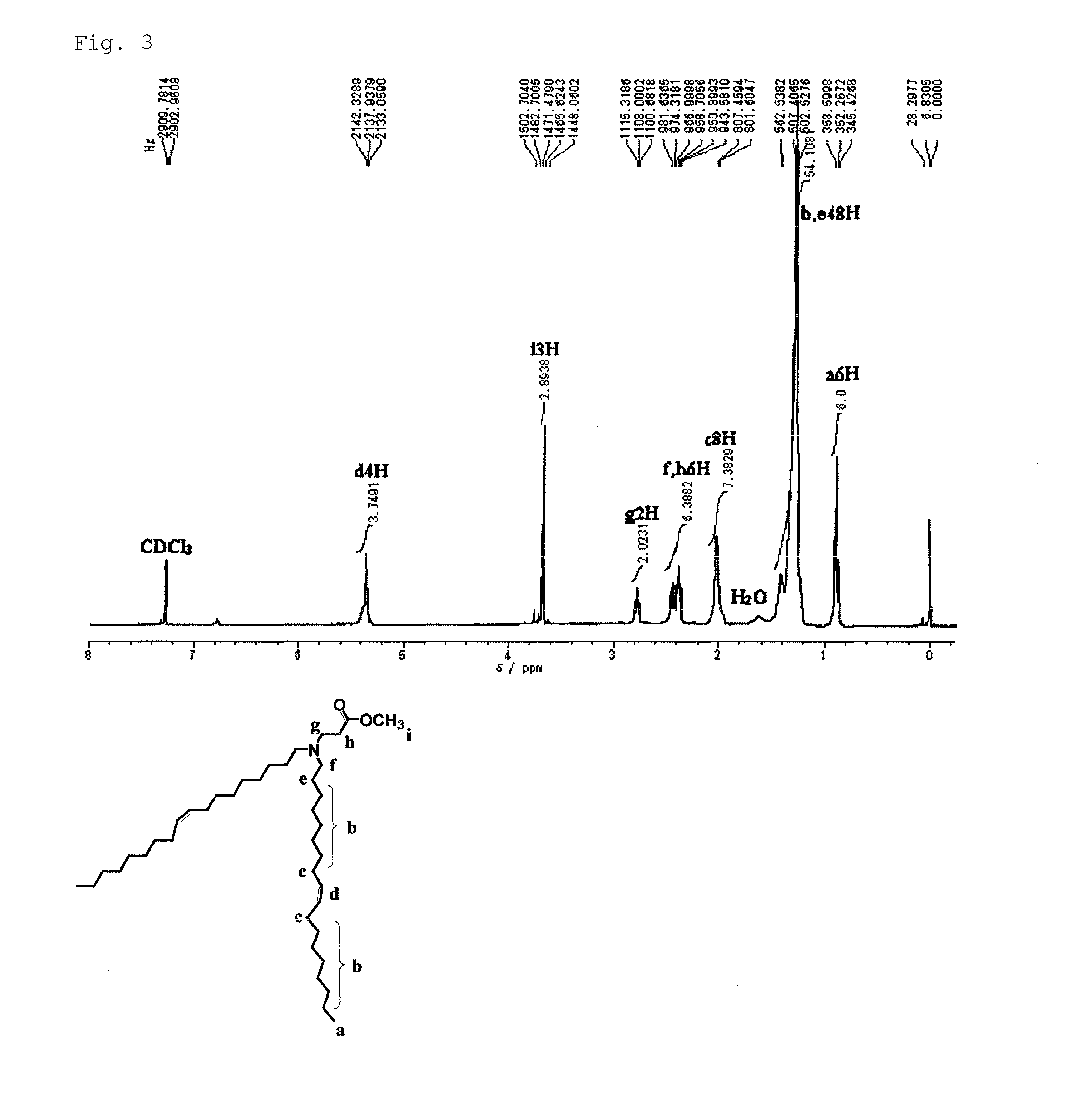Gene transfer agent composition containing polyamidoamine dendron
a technology of polyamidoamine dendron and gene transfer agent, which is applied in the field of gene transfer agent, gene transfer kit, gene transfer method, etc., can solve the problems of low gene transfer efficiency, non-viral vector death in clinical applications, and inability to transfer a single gene, so as to improve the efficiency of gene transfer, reduce cytotoxicity, and improve the effect of gene transfer efficiency
- Summary
- Abstract
- Description
- Claims
- Application Information
AI Technical Summary
Benefits of technology
Problems solved by technology
Method used
Image
Examples
example 1
Synthesis of Gene Transfer Agent Composition of Present Invention
1. Synthesis of Polyamidoamine Dendron
(1) Synthesis of Oleyloleoylamide
[0093]7.78 ml (20.0×10−3 mol) of oleoyl chloride was dissolved in 100 ml of dichloromethane, and N2 gas replacement was sufficiently performed. The reaction vessel was cooled in an ice water bath, and stirred. To the stirred solution, a solution obtained by dissolving 9.40 ml (20.0×10−3 mol) of oleylamine and 3.3 ml (0.024 mol) of triethylamine in 50 ml of dichloromethane was gradually added dropwise using a dropping funnel. Then, the mixture was stirred for 70 hours at room temperature while introducing N2 gas. After completion of the reaction, the solvent was distilled off using a rotary evaporator. The resulting crude product was separated and purified by open column chromatography (eluent: chloroform / ethyl acetate=2 / 1; filler: silica gel). The resulting crude crystal was recrystallized using ethanol at −20° C. The product obtained as a white sol...
example 2
Gene Transfer (1)
1. Method
[0129](1) Gene Transfer
[0130]HeLa cells derived from human cervical cancer were seeded in a 24-well dish at 5.0×104 cells per well, and cultured overnight at 37° C. in 0.5 ml of a DMEM medium containing 10% FBS. Then, the cells were washed twice with PBS containing 0.36 mM CaCl2 and 0.42 mM MgCl2 (PBS (+)). Next, 0.5 ml of a DMEM medium containing 10% FBS was added, and the cells were supplemented with a lipoplex (100 μl) containing 1 μg of plasmid DNA per well and incubated at 37° C. for 4 hours. Afterward, the cells were washed three times with PBS (+) to remove the lipoplex not incorporated into the cells. Then, 1 ml of a DMEM medium containing 10% FBS was added, and the cells were cultured at 37° C. for 40 hours.
[0131](2) Evaluation of Gene Transfer by Luciferase Assay
[0132]The cells treated with the lipoplex and cultured for 40 hours were washed twice with PBS (+), and further washed once with PBS (−). The cells were dissolved by addition of 50 μl of a...
example 3
Gene Transfer (2)
[0137]DL-G1-2C18-U2 (DL-U2) in which both of R1 and R2 represent unsaturated alkyl groups, which was obtained in Example 1; and DL-G1-2C18 (DL-G1), in which both of R1 and R2 represent saturated alkyl groups, were compared as described below.
[0138]pEGFP-C1 expressing a green fluorescent protein was used as a gene transfer plasmid, and COS-7 cells were used as target cells. Lipoplexes were prepared using, individually, DL-U2 and DL-G1. Then, gene transfer was performed.
[0139]Specifically, the following procedures were employed.
[0140]1. Method
[0141](1) Preparation of Lipoplex
[0142]Lipoplexes were prepared by the following procedures, using pEGFP-C1 as plasmid DNA expressing a green fluorescent protein.
[0143]A solvent was removed from each of chloroform solutions (1 mg / ml) of polyamidoamine dendrons (DL-G1 and DL-G1-U2) using a rotary evaporator to form 111.5 μg of lipid thin films. The thin films were dried in vacuo for 2 hours. Then, 500 μl of phosphate buffered sali...
PUM
| Property | Measurement | Unit |
|---|---|---|
| particle size | aaaaa | aaaaa |
| particle size | aaaaa | aaaaa |
| thickness | aaaaa | aaaaa |
Abstract
Description
Claims
Application Information
 Login to View More
Login to View More - R&D
- Intellectual Property
- Life Sciences
- Materials
- Tech Scout
- Unparalleled Data Quality
- Higher Quality Content
- 60% Fewer Hallucinations
Browse by: Latest US Patents, China's latest patents, Technical Efficacy Thesaurus, Application Domain, Technology Topic, Popular Technical Reports.
© 2025 PatSnap. All rights reserved.Legal|Privacy policy|Modern Slavery Act Transparency Statement|Sitemap|About US| Contact US: help@patsnap.com



